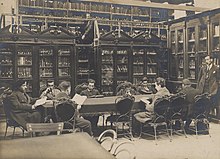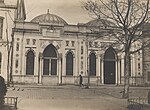Science and technology in the Ottoman Empire
During its 600-year existence, the Ottoman Empire made significant advances in science and technology, in a wide range of fields including mathematics, astronomy and medicine.
The Islamic Golden Age was traditionally believed to have ended in the thirteenth century,[1] but has been extended to the fifteenth[2] and sixteenth[3] centuries by some, who have included continuing scientific activity in the Ottoman Empire in the west and in Persia and Mughal India in the east.
Education



Advancement of madrasah
The
Education of Ottoman Women in Medicine
Harems were places within a Sultan's palace where his wives, daughters, and female slaves were expected to stay. However, accounts of teaching young girls and boys here have been recorded. Most education of women in the Ottoman Empire was focused on teaching the women to be good house wives and social etiquette.[5] Although the formal education of women was not popular, female physicians and surgeons were still accounted for. Female physicians were given an informal education instead of a formal one.[6] However, the first properly trained female Turkish physician was Safiye Ali. Ali studied medicine in Germany and opened her own practice in Istanbul in 1922, 1 year before the fall of the Ottoman Empire.
Technical education
Astronomy

Astronomy was a very important discipline in the Ottoman Empire. Ali Quşhji developed a model for Mercury.
After the destruction of the Constantinople observatory of Taqi al-Din in 1580, astronomical activity stagnated in the Ottoman Empire, until the introduction of Copernican heliocentrism in 1660, when the Ottoman scholar Ibrahim Efendi al-Zigetvari Tezkireci translated Noël Duret's French astronomical work (written in 1637) into Arabic.[9]
Geography

Ottoman admiral
His book contains detailed information on navigation, as well as accurate charts (for their time) describing the important ports and cities of the Mediterranean Sea. His world map, drawn in 1513, is the oldest known Turkish atlas showing the New World. The map was rediscovered by German theologian Gustav Adolf Deissmann in 1929 in the course of work cataloging items held by the Topkapı Palace library.[10]
Medicine
Medicine in the Ottoman Empire was practiced in nearly all places of society as physicians treated patients in homes, markets, and hospitals. Treatment at these different locations were generally the same, but different modalities of treatment existed throughout the Ottoman Empire. Different methodologies included humoral principles, curative medicine, preventative medicine, and prophetic medicine.[11] Ottoman hospitals also adopted the concept of integralism in which a holistic approach to treatment was used. Considerations of this approach included quality of life and care and treatment of both physical and mental health. The integralistic approach shaped the structure of the Ottoman hospital as each sector and group of workers was dedicated to treating a different aspect of the patient's well-being.[11] All shared the general consensus of treating patients with kindness and gentility, but physicians treated the physical body, and musicians used music therapy to treat the mind. Music was regarded as a powerful healing tune and that different sounds had the ability to create different mental states of health.[12]
One of the original building blocks of early Ottoman medicine was humoralism, and the concept of illness to be a result of disequilibrium among the four humors of the body. The four physiological humors each related to one of the four elements: blood and air, phlegm and water, black bile and earth, yellow bile and fire.[13]
Medicinal treatments in early Ottoman medicine often include the use of foods and beverages. Coffee, taken both medicinally and recreationally, was used to treat stomach problems and indigestion by working as a laxative.[14] The stimulant properties of coffee eventually gained recognition and coffee was used to curb fatigue and exhaustion.[14] The use of coffee in medicinal senses was done more in practice by civilians than hospital professionals.
Hospitals and related health-care institutions were referred to as a variety of names: dârüşşifâ, dârüssıhhâ, şifâhâne, bîmaristân, bîmarhâne, and timarhâne.
The first Ottoman hospital established was the Faith Complex dârüşşifâ in 1470; it closed in 1824.[15] Unique features of the hospital were the separation of patients by sex and the use of music to treat the mentally ill. The Bâyezîd Dârüşşifâ was founded in 1488 and is most recognized for its unique architecture that served as an influence in the architecture of later European hospitals.[15] The hospital built by Ayşe Hafsa Sulta in 1522 is recognized as one of the most esteemed hospitals of the Ottoman Empire.[15] The hospital devoted a separate wing for the mentally ill, until later limiting all treatment to only the mentally ill. The bîmârîstân's medrese provided medical students with combined theoretical and clinical coursework through hospital internships.[17]
Notable Ottoman medical literature includes the work of the Jewish doctor Mûsâ b. Hamun who wrote one of the first literature primarily about dentistry.
The first modern medical school of the Ottoman Empire was the Naval Medical School, or Tersâne Tıbbiyesi, established in January 1806.[17] The education of the school was largely European-based, using texts in Italian or French and medical journals published in Europe. Behçet Efendi founded the Imperial Medical School, Tıbhâne-I Âmire, of Istanbul in 1827 which was based on the following structural guidelines: the acceptance only of Muslim students, and the teachings would be almost entirely in French.[18] In 1839, after Tanzimat reforms, the school was opened to non-Muslim individuals as well.[18] After this point, non-Muslim students became the majority of graduating class and were better able to adapt and take advantage of the European-based education as many of them already spoke French and were placed into the higher ranking class in the school. The Civilian Medical School (Mekteb-I Tıbbiye-I Mülkiye) was founded in 1866 to raise the number of Muslim doctors.[17] The school’s teachings were done in Turkish and focused on training students to become civilian physicians rather than military physicians.[18]
Ottoman medicine in the mid-nineteenth century developed institutions for preventative medicine and public health.[21] A quarantine office and quarantine council, the Meclis-I Tahaffuz-I Ulâ were established.[22] The council eventually became an international organization with participation from European countries, the United States, Iran, and Russia.[22] The Quarantine Administration, founded in 1838, established permanent anti-plague quarantines, based on the western Mediterranean quarantine model, throughout the Ottoman Empire.[23]
The Ottoman Empire was also home to many institutions organized for the purpose of inoculation vaccination research and investigations. In Istanbul, the İstanbul Rabies and Bacteriological Laboratory was founded in 1877 for research in microbiology and the testing of rabies inoculation.[18] The Smallpox Vaccination Laboratory and the Imperial Vaccination Center were also created in the late nineteenth century.[18]
The first Ottoman hospital,
Physics
In 1574,
Mechanical technology
In 1559, Taqi al-Din invented a
.Mechanical clocks

The
He later designed an observational clock to aid in observations at his
An example of a watch which measured time in minutes was created by an Ottoman watchmaker, Meshur Sheyh Dede, in 1702.[31]
Steam power
In 1551,
Military

The Ottoman Empire in the 16th century was known for their military power throughout southern Europe and the Middle East. The
Ottoman
The
The musket appeared in the Ottoman Empire by 1465.[40] Damascus steel was used in the production of firearms such as the musket from the 16th century.[41] A musket is a long gun which materialized in the Ottoman Empire by 1465. These were large hand-held guns made out of steel and were capable of penetrating heavy armor; however, these guns by the mid-16th century disappeared because heavy armor declined. There were many more versions of the musket which eventually became known as the rifle. In the 15th century the Ottomans had perfected the musket by creating a gun that used a lever and spring.[42] These were much more easy to use during combat. Eventually the rifle as we know today ended the era of the musket
Turkish arquebuses may have reached China before Portuguese ones.[43] In 1598, Chinese writer Zhao Shizhen described Turkish muskets as being superior to European muskets.[44]
The Chinese military book
The Ottoman Empire military was also tactically proficient in the use of small arms weapons such as
See also
- List of Ottoman scientists
- Ali Qushji
- Hezarfen Ahmet Celebi, Ottoman aviator
- Lagari Hasan Celebi, Ottoman aviator
- List of inventions in the medieval Islamic world
- Piri Reis
- Science in the medieval Islamic world
- Taqi ad-Din Muhammad ibn Ma'ruf
- Timeline of science and engineering in the Islamic world
Notes
- ^ Matthew E. Falagas, Effie A. Zarkadoulia, George Samonis (2006). "Arab science in the golden age (750–1258 C.E.) and today", The FASEB Journal 20: 1581–6
- ISBN 0814780237
- ^ İnalcık, Halil. 1973. "Learning, the Medrese, and the Ulema." In The Ottoman Empire: The Classical Age 1300–1600. New York: Praeger, pp. 165–178.
- JSTOR 43293079.
- ^ "Muslim women healers of the medieval and early modern Ottoman Empire – Hektoen International". hekint.org. Retrieved 22 November 2019.
- ^ "ITU – History". www.itu.edu.tr. Istanbul Technical University. Retrieved 22 November 2016.
- ^ ISBN 0792340663.
- S2CID 171015647.
- ^ A. Gerber, Deissmann the Philologist, Berlin, 2010, 198–201.
- ^ ISBN 978-1-4384-2529-0.
- ^ – via JSTOR.
- ISBN 978-94-007-3934-5
- ^ ISBN 978-1-4384-2529-0.
- ^ a b c d İhsanoğlu, Ekmeleddin (2002). History of the Ottoman state, society & civilisation. Istanbul: IRCICA. p. 400.
- ISBN 978-1-4384-2529-0.
- ^ ISBN 978-94-007-3934-5
- ^ a b c d e f g h i İhsanoğlu, Ekmeleddin (2002). History of the Ottoman state, society & civilisation. Istanbul: IRCICA. pp. 400–506.
- ^ Kermelİ, Evgenia (2014). "The Tobacco Controversy in Early Modern Ottoman Christian and Muslim Discourse". Hacettepe University Journal of Turkish Studies. 11: 21 – via Google Scholar.
- ^ G. Bademci (2006), "First illustrations of female Neurosurgeons in the fifteenth century by Serefeddin Sabuncuoglu", Neurocirugía 17: 162–5
- ISBN 978-1-4384-2529-0.
- ^ JSTOR 10.3366/j.ctt3fgqx4.9
- .
- ^ Virk, Zakaria (2017). Muslim Contributions to Sciences. USA: Safir Rammah. pp. 101–102.
- ISSN 1301-0883.
- ^ "Ottoman Music Therapy « Muslim Heritage". 11 March 2009. Retrieved 22 November 2019.
- ISSN 2148-3736.
- ISBN 978-0-415-12410-2. : 779
- ISBN 0195189485.
- ^ "Monastic Alarm Clocks, Italian" Archived 21 November 2008 at the Wayback Machine, entry, Clock Dictionary.
- ^ Horton, Paul (July–August 1977). "Topkapi's Turkish Timepieces". Saudi Aramco World: 10–13. Retrieved 12 July 2008.
- Ahmad Y Hassan (1976), Taqi al-Din and Arabic Mechanical Engineering, p. 34-35. Institute for the History of Arabic Science, University of Aleppo.
- ISBN 9782600042932.
- ^ a b "Shotgun | weapon". Encyclopædia Britannica. Retrieved 22 November 2019.
- ISBN 9781351873765.
- ^ Ágoston 2005, pp. 45–46.
- ISBN 9780521398329., pp.79-80
- ISBN 1-84176-091-9., pp. 13, 22
- ^ Schmidtchen, Volker (1977b), "Riesengeschütze des 15. Jahrhunderts. Technische Höchstleistungen ihrer Zeit", Technikgeschichte 44 (3): 213–237 (226–228)
- ISBN 9781136277320.
- ISBN 978-0-262-66072-3.
- ISBN 978-0-262-66072-3.
- ^ Chase 2003, p. 144.
- ISBN 9780521303583.
- ISBN 9780521303583.
- ^ a b "Weapons of the Ottoman Army – The Ottoman Empire | NZHistory, New Zealand history online". nzhistory.govt.nz. Retrieved 22 November 2019.
References
- History of Astronomy Literature during the Ottoman Period by Ekmeleddin İhsanoğlu
- Ágoston, Gábor (2005). Guns for the Sultan: Military Power and the Weapons Industry in the Ottoman Empire. Cambridge: Cambridge University Press. ISBN 978-0521843133.
- Chase, Kenneth (2003), Firearms: A Global History to 1700, Cambridge University Press, ISBN 0-521-82274-2.
- "Weapons of the Ottoman Army - The Ottoman Empire | NZHistory, New Zealand history online". nzhistory.govt.nz. Retrieved 22 November 2019.
- 5 Weapons Used by the Ottomans, retrieved 22 November 2019
- "Ottoman military band", Wikipedia, 30 September 2019, retrieved 22 November 2019
- "Mehter-The Oldest Band in the World". web.archive.org. 1 January 2014. Retrieved 22 November 2019.
Further reading
- Science among the Ottomans: The Cultural Creation and Exchange of Knowledge by Miri Shefer-Mossensohn, 2015, University of Texas Press
